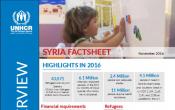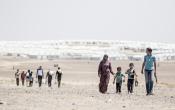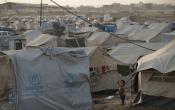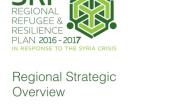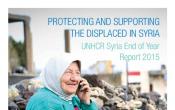Syrian Arab Republic
Operation: Syrian Arab Republic
Location
{"longitude":39,"latitude":35,"zoom_level":0}
Latest update of camps and office locations 21 Nov 2016. By clicking on the icons on the map, additional information is displayed.
Key Figures
| 2017 planning figures | |
| 2.9 million | IDPs will benefit from non-food item distribution |
| 180,000 | IDPs will receive legal assistance |
| 150,000 | IDPs will benefit from emergency shelter interventions |
| 150,000 | vulnerable IDP students will benefit from remedial and catch-up classes |
| 80,000 | IDPs will benefit from livelihood activities including vocational training and small start-up business grants |
| 2015 end-year results | |
| 3.2 million | internally displaced persons (IDPs) were reached with core relief items (CRIs) in 12 out of 14 governorates |
| 15,000 | IDPs and host community member benefitted from the vocational and life skills trainings |
| 100 | beneficiaries of cash vouchers for business start-ups |
| 27,400 | IDPs received legal assistance |
| 16,000 | refugees deemed most vulnerable received financial assistance |
| 2,160 | refugees and asylum-seekers received legal aid |
Latest Updates and Related Links
People of Concern
15%
Decrease in
2015
2015
| 2015 | 6,753,569 |
| 2014 | 7,947,655 |
| 2013 | 6,973,348 |

[["Refugees",21113],["Asylum-seekers",5251],["IDPs",6563462],["Returned refugees",189],["Stateless",160000],["Others of concern",3554]]
Loading ...
Budgets and Expenditure for Syrian Arab Republic
< Back
2015
{"categories":[2012,2013,2014,2015,2016,2017],"budget":[156.31257923,317.92470594,331.41534753,366.77411747,353.46223715,353.000068122],"expenditure":[123.37618395,231.88147006,205.04924968,173.76697349,null,null]}
{"categories":[2012,2013,2014,2015,2016,2017],"p1":[114.05797994,84.23797468,69.84079225,56.81599041,52.75013228,48.799999015],"p2":[0.49529929,0.70832734,0.57833829,0.17973042,0.1946423,0.21099997],"p3":[null,null,null,null,null,null],"p4":[41.7593,232.97840392,260.99621699,309.77839664,300.51746257,303.989069137]}
{"categories":[2012,2013,2014,2015,2016,2017],"p1":[89.18652361,40.80187504,40.86751359,23.27234083,null,null],"p2":[0.20035572,0.29587007,0.44117528,0.12660126,null,null],"p3":[null,null,null,null,null,null],"p4":[33.98930462,190.78372495,163.74056081,150.3680314,null,null]}
Loading ...
CHOOSE A YEAR
- 2014
- 2015
- 2016
- 2017
Working environment
Six years of conflict has had a devastating impact on the lives of all civilians in Syria, with humanitarian needs reaching an alarming level. According to the 2016 Humanitarian Needs Overview (HNO), 13.5 million persons are in need of humanitarian assistance, including 6.1 million internally displaced people (IDPs). Escalation of the conflict in 2016 led to a deterioration in the security environment and a further increase of internal displacement, consequently impacting the humanitarian situation. United Nations agencies and their partners were limited in their ability to deliver life-saving humanitarian support, particularly to the 5.47 million people living in besieged and hard-to-reach areas. The humanitarian situation in the city of Aleppo and its surroundings has deteriorated severely, with some 275,000 people in the eastern part of the city facing movement restrictions and in need of urgent assistance. Almost all aspects of civilian life have been affected, resulting in a range of interlinked protection risks.Key priorities
UNHCR’s key priority in 2017 will be to continue providing life-saving assistance to IDPs across the country; particularly in hard-to reach and besieged areas, in order to address the large-scale humanitarian needs throughout all governorates. UNHCR will continue to engage the Government in raising protection concerns and finding appropriate solutions. UNHCR will continue to focus on enhancing the protection of people of concern through a wide range of integrated community-based activities, with particular attention to improving access to civil documentation, strengthening the prevention of and response mechanisms to sexual and gender-based violence (SGBV), and the protection of chil¬dren as well as services for persons with specific needs. UNHCR will also work towards strengthening the resilience and reducing vulnerabilities of people affected by the conflict. UNHCR will continue to register new asylum-seekers, provide protection services and identify durable solutions including resettlement and voluntary repatriation for refugees. In the context of the whole-of-Syria approach, UNHCR will continue to lead the Protection, Shelter and Non-Food Items (S/NFI), and Camp Coordination and Camp Management (CCCM) clusters, and deliver cross-line and cross-border assistance to affected populations.The comprehensive needs of the UNHCR operation in Syria for 2017 amount to USD 353 million. In the event of funding shortfalls, some 77,500 IDPs will be left without emergency shelter; at least 500,000 individuals, will not have access to 40 community centres which would have been established; 250,000 IDPs will not receive psychosocial support; 400,000 families will not receive urgently needed core relief items (CRIs); and monthly financial assistance will only be provided to 20 per cent of the refugee population.

